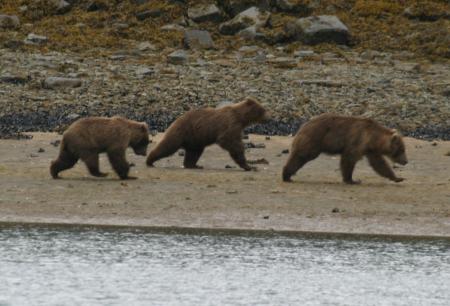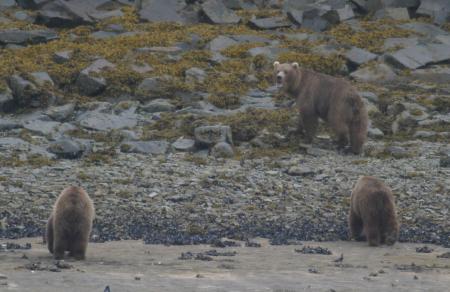Take a look at the series of pictures of the bear family. I have been visiting this family for three years now, since they were nearly newborn cubs. This year, they are on their own for the first time, and it is very likely the next time I visit, they will have become solitary bears (the lifetime norm for bears). This means, in a place with a lot of bears, I won't be able to pick them out any longer.
This is a situation steeped in irony. Compared to most people I've known, I know these bears better, and have known them for a longer time. Also, as you get to know people, at some point they may take an opportunity to explain themselves to you, after which you may not know them at all in any realistic sense.
Sensing an older male bear.
Unlike people, bears don't try to explain themselves to you. Apart from the obvious reason that they can't articulate the lies on which most human relationships depend, there is also the fact that you are quite irrelevant to them — unless you let them eat you, more on this later, a way to get close to bears that has some serious practical drawbacks.
These three siblings have always been rather distinctive — mama bears don't usually create a litter of three, one of the three cubs invariably lies down as soon as the group stops moving, and even during this, their first year of independence, they've remained as a group, so when I saw them I knew right away who they were.
Young bears, even at this age, are very vulnerable to attack by older, particularly male, bears, and I watched these three bears run away from a number of potential attackers. Another issue on the Alaska Peninsula is that hunting is not allowed, as a result there are a lot more bears than there is food for them. I watched a number of bear-on-bear attacks, some obviously stressed bears whose ribs were showing (in May), and, overall, a whole lot of bears.
I worry about the bear that always lies down. This may be because he is particularly lazy and takes every opportunity to rest, or it might suggest something more serious. In this environment it pays to remain alert and poised to run away at a moment's notice.
On nearby Kodiak Iskand, where hunting is allowed, there are fewer bears and much more food. As a result, the bears tend to be peaceful and not much trouble at all. While kayaking the west side of Kodiak Iskand I visited a family (of humans) who lived in a pretty, remote spot on the shore of an inlet. They allowed their small children to play outdoors without restriction. I asked the obvious question, "Aren't you worried about bears attacking your children"? "Not at all," they replied. As I paddled away in my kayak, within a mile of the children I encountered a bear eating sedge grass on the shore. He looked at me with complete passivity and resumed foraging. I thought to myself this was not at all like the bears on the Peninsula.
I want to emphasize I am not taking a position on hunting. I have just noticed a dramatic behavioral difference when comparing Peninsula and Kodiak Island bears.
When I first arrived at Geographic Harbor this year, after anchoring I decided to survey the scene with binoculars for a while. I watched two bears slowly approach each other in the thick brush. I realized because of my position I could see both of them, but they couldn't see each other. Finally they came into mutual view and experienced a moment of raw fear. But the fear evaporated and they decided to approach each other. Then, in what would have been a wonderful picture, they leaned out and touched muzzles for a second.
I know bears have an extremely acute sense of smell, and that muzzle contact probably conveyed volumes of information unimaginable to you or me. And in a bear's abbreviated version of social interaction, that brief touch probably counted as a hot date.
Well, as things turned out, one of the bears was male and the other female. After the muzzle moment, the male bear (how shall I say this on a G-rated page?) began to exhibit some further interest, but the female growled and let him know she wasn't interested. Unlike humans, bears don't have a problem with unwanted advances, because males and females are about equal in size and strength — if a male bear were so foolish as to ignore a female's clearly expressed rejection, he would soon be missing an ear, a paw, or some other cherished body part.
The male bear wisely acceded to the female's wishes and the bears began to split apart. Just then I heard a shout, a protesting voice, echoing off the surrounding rocks. I realized it was my voice, saying, "Come on — give the guy a break, you tease!" One of the bears looked at me with the mildest curiosity before returning to the sedge grass.
This entire episode took all of 15 seconds, nowhere near enough time for me to get my hands on a camera. I would guess every photographer remembers a dozen terrific missed photographs for each one whose light actually falls on his lens.


 Share This Page
Share This Page

 Share This Page
Share This Page








 Share This Page
Share This Page